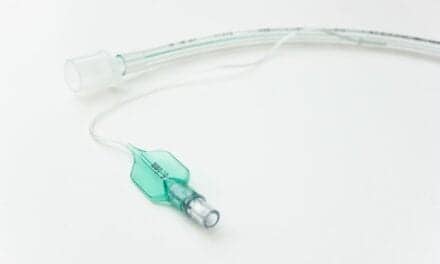Adverse patient effects due to clinical alarm fatigue are consistently rated near or at the top of lists of most pressing healthcare technology hazards. So what can clinicians do to change that?
By Phyllis Hanlon
Alarm fatigue continues to be a major healthcare concern, ranking third on the ECRI Institute’s Top 10 Health Technology Hazards for 2017. So manufacturers and their customer hospitals persist in exploring ways to reduce the incidence of this patient and clinical staff safety hazard.
Mechanical ventilators are often one of the major sources of an alarm and several manufacturers have developed technology to reduce the incidence of non-actionable alarms. Ease of use within the context of alarm management is key to patient safety, according to TJ Rivera, director of global marketing, ventilators, at Zoll Medical Corp. He cited SmartHelp, a unique Zoll technology that guides users through alarm resolution.

“SmartHelp on Zoll ventilators guides the user through step-by-step checks to determine the cause of the alarm,” Rivera said. “For example, if a patient disconnects from the ventilator, a distinct audible and visual alarm alerts the clinician.”
While ventilators have default alarm settings, the ability to customize those settings is important. “Our product has an intuitive and simple touch, turn and confirm interface to allow the user to change parameters,” Rivera said. “Users can customize settings to suit the needs of the individual patient.”
Integration
While individual medical devices are equipped with customizable settings and self-help technology, significant amounts of data captured and analyzed fail to prompt a response, according to Andy Weissberg, senior vice president, marketing communications at Quantros. “My data says ninety percent of alarms result in no action,” and asserts there is a “huge disconnect” between the alarm itself and the trigger. “[It] starts with the way the alarms are situated, whether integrated or attached to critical clinical information about the patient. It’s not just clinical, [but] other information that might force the need to take action or not. Scaling those things are not embedded in core systems.”
To maximize alarm management, Weissberg recommends a comprehensive integrated system with the electronic health record (EHR) at the core. He explained that Quantros interfaces all hospital systems “…for efficiency, accuracy, reconciliation and investigation, root cause analysis and reporting analysis. We take a very patient centered view on safety. Personalizing alarms is at the core of the philosophy of aggregating information and making it actionable. This is exactly how this problem should be fixed,” he said. “Hospitals are taking a much deeper patient centered view on who patient is, what the conditions are, stratifying risk using EHRs and other systems by making information available and [using] best practices about how to handle a patient based on who the patient is.”
Process
John Zaleski, PhD, CAP, CPHIMS, chief analytics officer, Bernoulli, said the process of ameliorating alarms requires various emphases. “One is studying workflow in these environments. You need to determine a way to respond to alarms that can mitigate the strain on the care providers,” he said. “When you use teletext, telemonitoring or remote monitoring for alarms, it relieves some of the burden on the local staff who have to respond to alarms.”
“Another focus relates to an understanding of the cohort of patients, their diagnosis, demographics, and whether widening the alarm thresholds can ameliorate certain alarm conditions,” Zaleski continued. He suggested locating specific patient cohorts in one unit or on one floor and using “…precision-guided alarm settings if you expect certain behaviors in certain cohorts.”
Quality studies help hospitals understand the environment while creating protocols and guidelines for alarm management. “[These trials should] be driven by the clinical organization under close supervision of clinical leadership and, if conducted properly, should be done under IRB protection. That [should be] the imprimatur for patient safety versus just wanting to reduce headaches from alarms,” Zaleski said. “[You] really need to focus on the ground troop aspect of verifying whether techniques in the process of reducing alarms are imposing a burden or increasing the likelihood of false negatives. Safety trials in clinical environments use good clinical principles to assess whether changes are meaningful.”
Zaleski recommended an integrated solution and said, “Combinatorial alarms take multiple sources of information and bring it together to corroborate events. This is not simply limited to data extracted in real time from patient care devices at the point of care, but can also be drawn from ancillary sources.”
Technological Challenges
Once clinical studies establish goals, the system for communicating data—whether alarms or raw data—should meet requirements for intervention, Zaleski noted. All involved parties, including operational staff, those who procure the system and vendors, should understand the system’s capabilities and limitations. “Some healthcare systems may opt to take separate systems or pieces of technology and loop them together,” he said, pointing out that individual technologies may not be capable of accomplishing the end goal. “The thing to remember is if you take all the systems and link them together, you have one soup-to-nuts system that collects and distributes information, guaranteeing delivery. If you ‘Frankenstein’ the interface, guaranteeing delivery of the message is a challenge, a basic one for which a single system has an answer.”
Moreover, when a hospital creates this type of system, it “effectively takes on the burden of becoming manufacturer,” Zaleski said. “When a patient is harmed, it exposes the hospital to FDA oversight because by creating a ‘Frankenstein.’ they’ve become a manufacturer. More important, it exposes the patient to a safety risk.”
Change Management
Larry Boyd, director, Carescape Monitors at GE Healthcare, emphasized that a successful alarm reduction program involves change management within a hospital and among its clinical teams. Lasting change should be based “…in real data and, just like in any clinical setting, evidence based medicine…” to make important decisions about managing alarms. “No technology can solve all issues without being very clear of the roles and responsibility of unit personnel,” he said.
To help hospitals develop appropriate systems, GE Healthcare offers alarm management consulting through its clinical service team. “This helps guide the hospital through a multi-step improvement process, creating a work plan to improve that [process] to be able to measure and sustain improvement,” said Boyd. “We work with clinicians every step of the way, offering support through user group meetings, peer-to-peer sharing, interviews and workshops with clinicians and medical staff.”
Boyd also pointed out that a database-type alarm reporting tool helps chart technical and clinical alarms. “[It’s] all about getting the right data into the clinicians hands so they can make better decisions,” he said.
An alarm management tool that makes data visible to the clinical team enables them to review what has been happening and determine if changes could result in fewer alarms, according to Matti Lehtonen, general manager, Anesthesia & Respiratory Care at GE Healthcare. He added that analytical tools focused mainly on the patient prompts clinicians “… to think about change management and what can they do differently to make care more efficient and less of a burden.”
Lehtonen pointed out, while hospitals have alarm protocols, they need to allow for variability. “Because with some patients at different stages of therapy you might require different settings to make sure you catch the right ones and discard the unnecessary ones,” he said. “It really boils down to understanding the product, being properly trained on it and being able to understand the physiological background. Aside from the technology solution, that is most important—the education piece. You have to understand your tools.”
Boyd reported that GE Healthcare is also exploring the idea of delivering alarms with contextual data to a mobile phone. This delivery system would enable clinicians to make a “walk-run decision” and would provide “…the care collaboration that many hospitals are looking to gain by using mobile phones.”
Interface Capability
Felix Baader, business leader, Patient Monitoring, Philips, asserted the onus is on the manufacturer to develop ventilators that provide effective guidance in alarm notifications, as well as to provide “smart alarms” that take action to either resolve the condition or prevent nuisance alarm activations.
“Philips has a device interfacing capability, called IntelliBridge, which allows us to interface many third-party devices to our patient monitoring systems and allow the display of waveforms, numerics and alarm information in one place, as opposed to needing to look at multiple devices,” said Baader. “Today, there are not many devices that enable the ability to respond to or reset the alarms from these third-party devices (primarily for regulatory reasons), but this technology is set up to allow this communication. It can also greatly enhance the ability to log all sources of nuisance alarms from all devices, not just those coming from Philips monitors.”
The ideal system would also offer features that help prevent patient/ventilator asynchrony and thus prevent alarm conditions from ever occurring. “Our Auto-Trak technology has benefitted patients for years by automatically setting the trigger and cycling thresholds, even in the presence of dynamic leaks,” said Baader. “This has greatly reduced those alarms associated with ‘fighting the ventilator.’ Our Flow-Trak technology provides the patient with additional flow when needed to reduce the incidence of flow starvation episodes and the resulting alarms that could be triggered.”
At Augusta University Health implementation of a new solution resulted in a 40% decrease in preventable alarms in the ICU and on its telemetry floor, according to Kevin Dellsperger, MD, PhD, vice president and chief medical officer and associate dean for Clinical Affairs. “AUH has a project team that developed an escalation protocol that includes definitions of urgency including how quickly contact with a physician is needed,” he said. “Through the implementation of the Philips IntelliVue Guardian Solution and a new process to identify deterioration, AU Health successfully reduced predictable codes by 89% on two pilot medical surgical wards.”
Dellsperger added that an Early Warning Scoring (EWS) system that uses vital signs at regular, ideally continuous, intervals, such as respiratory rate, heart rate and blood pressure provides trended data for more accurate risk stratification of the patient to reduce on unnecessary alarms.
Although significant reduction in non-actionable alarms continues to present a challenge, manufacturers together with their hospital customers continue the search for answers.
RT
Phyllis Hanlon is a contributing writer to RT. For further information, contact [email protected]










